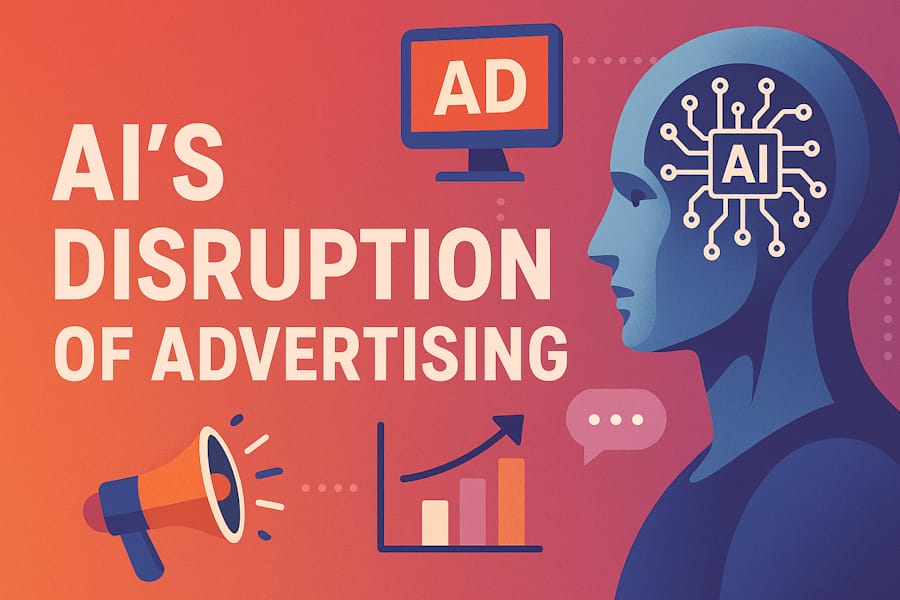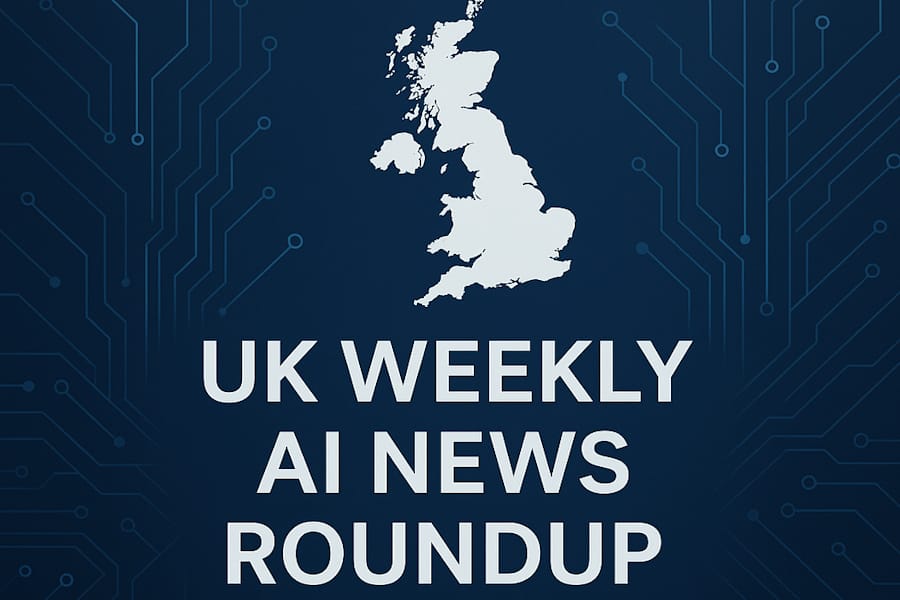AI’s Disruption of Advertising
Innovation, Job Losses, and the New Creative Frontier

Publish Date: Last Updated: 30th December 2025
Author: nick smith- With the help of CHATGPT
From personalized ads that seem to read your mind to visuals crafted in seconds by algorithms, artificial intelligence (AI) is not just influencing advertising—it’s reinventing it. As the line between creativity and code blurs, we are entering a new era where machines co-create with marketers. But with this revolution comes both opportunity and upheaval. This article explores AI’s far-reaching impact on the advertising industry—from automating entry-level roles to opening doors for new hybrid professions—highlighting the opportunities, threats, and the urgent need for reskilling.
AI in Advertising: From Buzzword to Backbone
AI is now deeply embedded in advertising workflows—from crafting copy to buying ad space. A 2024 Statista report revealed that the advertising sector leads all industries in generative AI adoption, with 37% of marketers using tools like ChatGPT, MidJourney, and DALL·E to create campaigns, analyze consumer behavior, and optimize targeting.
According to AdExchanger, AI-driven programmatic advertising already accounts for over 80% of U.S. digital ad spend. Small businesses, once outgunned by large corporate budgets, now use AI-powered tools like Smartly.io and Jasper to launch highly targeted, cost-efficient campaigns.
But this empowerment comes with consequences, especially for the traditional workforce.
Democratization of Advertising: Empowering the Underdogs
One of AI’s most exciting impacts is how it levels the playing field. Small businesses and independent creators can now produce full-scale campaigns using minimal resources. Platforms like Lumen5, Canva’s AI suite, and Synthesia enable lean teams to create video, visual, and written content that once required a professional agency.
This has fueled a wave of niche and hyperlocal brands gaining traction online. However, it also increases competition, saturates attention spans, and puts pressure on creative differentiation.
Displacement in the Age of Automation
AI’s efficiency is driven by automation—particularly in repetitive, data-heavy, or creative-production tasks. This has put numerous traditional advertising roles at risk:
- Copywriters & Content Creators: Generative AI can now produce tailored ad copy and variations in seconds, reducing demand for entry-level writers. A 2025 World Economic Forum report estimates that 50% of tasks in market research and writing roles could be automated.
- Media Buyers & Planners: Programmatic platforms are automating placement and bidding, displacing traditional media planning jobs.
- Graphic Designers: Tools like Adobe Sensei and Canva’s AI features automate design templates, reducing production time by up to 40% and impacting junior design roles.
A 2023 McKinsey report projects up to 800 million jobs globally could be affected by automation by 2030. In advertising, roles that rely on data entry, admin, or repetitive design tasks are especially vulnerable. Notably, the ILO highlights that women—who hold the majority of white-collar roles in advertising—face 21% higher exposure to automation.
Forecast: Projected Job Losses by 2030
- 92 million jobs globally could be displaced by AI, per the World Economic Forum’s 2025 Future of Jobs Report.
- In the U.S., Goldman Sachs projects 300 million jobs could be lost or degraded by AI across all sectors.
- Clerical support roles in Latin America, particularly those held by educated women in cities, are at the highest risk of automation-induced displacement.
However, it’s important to maintain perspective. A 2013 Oxford study overestimated automation risks, and the Bureau of Labor Statistics (BLS) emphasizes that the pace of job losses is highly dependent on economic conditions and adoption rates.
Affected Areas: Where AI Hits the Hardest
- Creative Development: Entry-level creatives face challenges as AI tools generate copy, images, and videos.
- Media Buying: Over 80% of digital ad spend now flows through AI-powered platforms.
- Analytics & Research: AI tools like GA4 and Sprout Social offer automated insights, reducing the need for junior analysts.
These trends are creating a “hollowing out” of junior roles—posing long-term risks for career development, especially in agencies that prioritize cost-cutting.
AI’s Silver Lining: New Careers and Hybrid Roles
Despite displacement, AI is also spawning entirely new roles within advertising:
- AI Specialists & ML Engineers: Essential for building and fine-tuning AI ad tech.
- Data Scientists & Analysts: Demand for human oversight of machine-driven insights is growing fast.
- Digital Transformation Consultants: Help agencies integrate AI into legacy workflows.
- Ethics & Compliance Officers: Critical for navigating regulations like GDPR and CCPA.
Emerging hybrid roles like prompt engineers and AI content strategists blend creativity with machine logic. A 2025 PwC report highlights a 25% wage premium for AI-savvy professionals.
How AI Powers Today’s Advertising
AI’s applications span the full campaign cycle:
- Targeting & Personalization: Predictive models on Meta and Google deliver hyper-targeted ads with up to 30% more effectiveness.
- Creative Production: Tools like DALL·E and Jasper create scalable visuals and copy at a fraction of the traditional time and cost.
- Optimization: Programmatic tools adjust bidding and placements in real-time.
- Analytics & Sentiment Analysis: Brands can now track audience sentiment before campaigns even launch.
- Innovations: Conversational ads (chatbots), AR/VR campaigns, and carbon-reducing delivery models are shaping the next frontier.
Challenges & Ethical Red Flags
AI in advertising faces serious ethical and technical challenges:
- Privacy Regulations: Apple’s App Tracking Transparency and GDPR have tightened data access, limiting targeting precision.
- Bias in Algorithms: A 2024 Forbes article documented how AI ad systems inadvertently prioritized high-income white audiences, marginalizing others.
- Creativity Concerns: While efficient, many AI-generated ads have been criticized as “generic” or lacking emotional nuance.
- Consumer Fatigue: In 2024, 40% of internet users globally used ad blockers—many citing over-personalization and intrusive formats.
“AI can optimize reach but not always resonance.” — Comment from @sabrinacreates on X
The Reskilling Imperative
To future-proof the workforce, reskilling is critical. The World Economic Forum estimates that 39% of key skills will change by 2030, with digital literacy becoming a baseline requirement.
- Educational initiatives, such as Nexford’s AI-focused BBA and MBA, are helping professionals transition into data or tech-forward roles.
- AI itself is also part of the solution—tools now help job seekers rewrite CVs, prepare for interviews, and match with new opportunities.
- The ILO advocates for “transition safety nets”, including financial support for those displaced and incentives for companies to retrain rather than replace.
Conclusion: Creativity, Caution, and Co-Evolution
AI in advertising is not the end of human creativity—it’s a redefinition of it. Yes, jobs are changing. Yes, some are disappearing. But new, more strategic, and interdisciplinary roles are emerging in their place.
The industry now faces a choice: automate everything and risk creative sterility—or strike a balance that values both the machine’s efficiency and the human touch. The winners in this new age of advertising will be those who adapt early, embrace reskilling, and treat AI not as a threat, but as a collaborator.
“AI won’t replace marketers, but marketers who use AI will replace those who don’t.” — MarketingProfs, 2025
Latest AI News Articles
AI Questions and Answers section for AI Impact On Advertising
Welcome to a new feature where you can interact with our AI called Jeannie. You can ask her anything relating to this article. If this feature is available, you should see a small genie lamp above this text. Click on the lamp to start a chat or view the following questions that Jeannie has answered relating to AI Impact On Advertising.
Be the first to ask our Jeannie AI a question about this article
Look for the gold latern at the bottom right of your screen and click on it to enable Jeannie AI Chat.







